Polymeric MATERIALS (POLYMERS)
General Structure
General Properties
Three Main Classifications of Polymeric Materials
Alternative Classification of Polymeric Materials
As always, these are imperfect categorizations and there is overlap.
Polymerization Reactions
Polymers are made or “polymerized” by chemical reactions. These reactions bond small simple hydrocarbon (organic) molecules from coal and petroleum products, usually in the gaseous state, into large macromolecules (long chains or networks) that are solids. There are two types of polymerization reactions.
1. Addition (Chain Growth) Polymerization
Some of the common simple hydrocarbons that go into the polymerization reactions:
As MW
so does Tm
Carbon has four electrons in sp3 orbitals that can each form a covalent bond. If each of these electrons bond with a different atom, the bonds will all be single bonds. If two (or three) of these electrons bond with the same atom, then there will be a double (or triple) bond.
Some common polymers that result from these polymerization reactions:
Size of Polymeric Molecules
Molecular size is quantified by the degree of polymerization, DP (the number of mers on a molecular chain) or as its molecular weight.
Since there are varying sizes of molecules, a statistical distribution must be used to quantify it.
The four methods are:
The molecular length is obtained by considering the fact that the bond angle for the sp3 hybrid orbitals of Carbon is 109o. This gives the chain a zig-zag configuration. The extended length of the molecule can be calculated as: Lext = ml [sin (109o/2)] where l is the length of a single bonds in the backbone of hydrocarbon chain and m is the number of bonds. (note m=2n)
However, there is more to the story as you consider that a single bond along the chain can rotate 360o to give a very kinked, coiled and twisted conformation. The effective length of the molecule, from a statistical analysis of a freely kinked linear chain, is therefore L = l Öm called the root mean square length.
Polymer Molecular Structure
Linear or chain structures are formed from bifunctional mers. These can have side groups attached.
Branched structures
are structures where a
chain is attached to a
point on another linear chain.
Crosslinked structures are structures where chains are connected at various points. For example an important process in elastomers is called vulcanization which is essentially just crosslinking. It is a nonreversible chemical reaction at high temperature in which Sulfur atoms bond with adjacent polymer backbones. Light crosslinking that is widely dispersed throughout material gives the best properties. (Silicone rubbers replace the -C- with -Si–O- on the backbone)
Network structures are formed from trifunctional or polyfunctional mers.
Note that in general rigidity and melting point tend to rise with:
This effect is due to hindrances to molecular sliding and greater secondary bonding forces acting.
Polymer Crystallinity
The polymer structures tend to be very complex because they involve large molecules. In fact the unit cell might only include a portion of a molecular chain. Due to the complexity of the structure, the chain disorder, misalignment, etc. 5-95% of the volume of a polymer can be non-crystalline.
Semi-crystalline structures can be compared to two-phase metals. The percent crystallinity can be found by measuring the density and knowing the density of the crystal phase and the amorphous phase:
The degree of crystallinity will increase with:
As crystallinity increases so does:
Polymer Crystal Models
Melting Temperature & Glass Transition Temperature of Polymers
Tm & Tg usually define, respectively, the upper and lower temperature limits for applications of semi-crystalline polymers. Tg may also define the upper use temperature for amorphous materials.
Methods used to increase Tm & Tg:
The viscosity, h can specify the behavior of polymers in these various regions. The viscosity is the material property that measures resistance to flow by shear forces. It is the proportionality constant between the shear stresses and the velocity gradient: t = h dv/dy
Viscoelasticity is a combination of viscous and elastic behavior. It is both time dependent (a form of anelasticity) and temperature dependent. (Think of silly putty.)
The phenomenon of viscoelastic Creep a result of viscoelasticity.
It is the time-dependent deformation of polymers when the stress level is maintained constant.
It will depend on temperature and can even have significant effects at room temperature for polymeric materials. Creep tests are conducted in same manner as for metals.
A common parameter to quantify this behavior of polymeric materials is the creep modulus, Ec(t) = so/e(t) where e (t) is the measured time dependant strain and so is the constant stress level at a specific temperature.
The phenomenon of stress relaxation is also a result of viscoelasticity.
It is the time-dependent relaxation of stress when the strain level is maintained constant.
It will depend on temperature and can even have significant effects at room temperature for polymeric materials.
A common parameter to quantify this behavior of polymeric materials is the relaxation modulus, Er = s(t)/eo where s(t) is the measured time dependant stress and eo is the constant strain level at a specific temperature.
Polymer properties are very sensitive to:
Typical stress-strain curves for the three different types of polymers
Deformation of Polymers
Polymers in general experience large elastic and plastic deformations. (Hence the term “plastics”.)
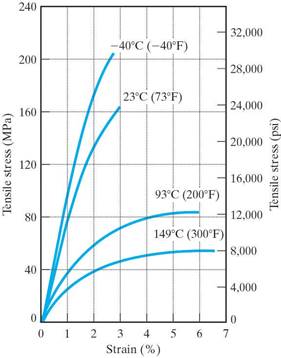
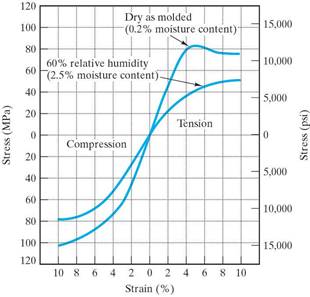
Elastic deformations in thermoplastics come from chains uncoiling and stretching. This is reversible. When forces are removed, the chains revert to their original conformations. On the atomic level the primary bonds are being stretched but not broken.
Plastic deformations come from the chains moving past one another. On the atomic level the secondary bonds are being broken and reformed. Finally, with enough stress, the primary covalent bonds within the chains are broken.
Any double bond on a chain is rotationally rigid and so will restrict ability of chain to rotate freely, making the material more rigid.
Bulky side groups will also restrict chain rotation (called steric hindrance) making the material more rigid.
The property of a polymer can vary greatly with T. Consider the plot of modulus of elasticity as a function of temperature for a typical thermoplastic with approximately 50% crystallinity:
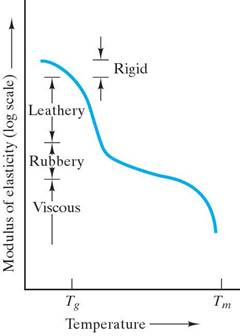
Below Tg the polymer behaves like a metal or ceramic. (Although the value of the modulus is substantially lower.)
In the Tg range, the modulus drops precipitously and the mechanical behavior is termed leathery – it can be extensively deformed and slowly returns to original shape upon removal of the stress.
Just above Tg a rubbery plateau is observed. In this region extensive deformation is possible with rapid spring back to the original shape upon removal of the stress.
Notice that with polymers we have extensive nonlinear elastic deformation.
When Tm is reached, the modulus again drops precipitously and we enter the liquid-like viscous region. (A more precise term would be decomposition point rather than a melting point.)
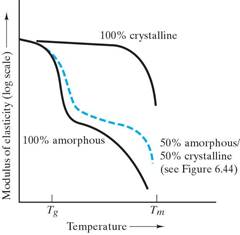 The behavior of the 50% crystalline thermoplastic is midway between the fully crystalline material and a fully amorphous material.
The behavior of the 50% crystalline thermoplastic is midway between the fully crystalline material and a fully amorphous material.

A structural feature that will affect the mechanical behavior in polymers is cross-linking of adjacent linear molecules to produce a more rigid, network structure. The effect is similar to increasing crystallinity.
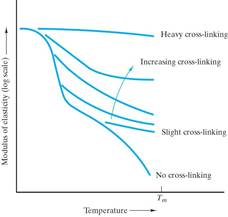
Elastomers
are materials that experience vast elastic deformations. The huge elastic strains in these materials are primarily due to uncoiling of the long chained molecules. Deformation is also due to the sliding of molecular chains over each other (breaking and reforming secondary bonds) and then finally the stretching of primary bonds along the backbone of the carbon chain. Hence the elastic modulus increases with increasing strain as shown here in the stress – strain curve for a typical elastomer:
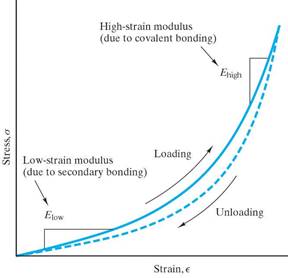
The low strain modulus has a low value because the forces needed to uncoil the molecular chains are small. The high-strain modulus has a higher value because stronger forces are needed to stretch the primary (covalent) bonds. Both regions involve overcoming secondary bonding, which is why the elastic modulus for these materials is significantly less than for metals or ceramics.
Tabulated values for the elastic modulus for elastomers are usually for the low strain regions.
Note that the recoiling of the molecules (during unloading) has a slightly different path than the uncoiling (during loading). This defines hysteresis. Hysteresis is behavior in which a material property plot follows a closed loop. In other words, it does not retrace itself upon the reversal of an independent variable, in this case the stress. The area of the loop is proportional to the energy absorbed in each cycle of the loading.
Deformation of Elastomers
Elastomeric deformations are very large and recoverable. The tensile modulus of elastomers is typically small and varies with strain. (i.e. it is non-linear)
This behavior comes from the elastomeric structure:
Cross-linking provides a mechanism to delay plastic deformation by acting as anchors (chains sliding past one another)
Consider the plot of modulus of elasticity as a function of temperature for a typical elastomer:
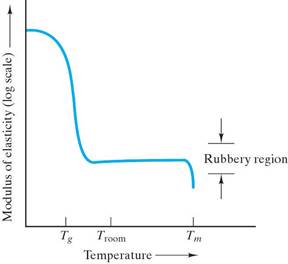
The rubbery plateau is pronounced and establishes the normal room-temperature behavior. (Tg is below room temp.)
The plot of modulus of elasticity as a function
of temperature for some commercial elastomers:
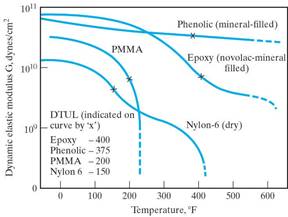
Note: DTUL in these curves is the deflection temperature under load, a parameter frequently associated with Tg . (It is defined as the temperature at which a standard test bar deflects a specified distance under a load. It is used to determine short-term heat resistance. It distinguishes between materials that are able to sustain light loads at high temperatures and those that lose their rigidity over a narrow temperature range.)
Drawing
Elastomers usually have ductile failures but can be brittle below Tg.
Thermoplastics can fail in either ductile or brittle mode.
Below Tg thermoplastics tend to have elastic behavior and fail in the brittle mode.
Above Tg thermoplastics tend to behave plastically or viscously (sometimes called visco-elastic behavior) and fail in the ductile mode.
Thermosets usually have brittle failures.
Strain rate will also affect which mode plastics will fail in: high strain rate will cause brittle failure, low strain rates will cause ductile failure.
To strengthen Thermoplasts:
But, as usual, there will be a corresponding decrease in the ductility.
To strengthen Thermosets:
1. Increase the network.
2. Add glass fibers.
Polymer Additives
Foreign substances to modify and enhance the properties of polymers
Common Polymeric Materials
Thermosets
The word “plastic” is used in many different ways and so can be very confusing.
Sometimes it is used as a synonym for the word polymer although this is not strictly correct.
Sometimes it is used as a synonym for thermoplastic polymers which is just one of the three classifications of polymers.
Sometimes it is used to mean a polymer that has elastic, yielding and plastic regions in the s-e curves, similar to metals.
Sometimes it is used to mean the largest category of polymer applications.
Source: https://fog.ccsf.edu/~wkaufmyn/ENGN45/Course%20Handouts/Chap13_Polymers.doc
Web site to visit: https://fog.ccsf.edu/
Author of the text: indicated on the source document of the above text
If you are the author of the text above and you not agree to share your knowledge for teaching, research, scholarship (for fair use as indicated in the United States copyrigh low) please send us an e-mail and we will remove your text quickly. Fair use is a limitation and exception to the exclusive right granted by copyright law to the author of a creative work. In United States copyright law, fair use is a doctrine that permits limited use of copyrighted material without acquiring permission from the rights holders. Examples of fair use include commentary, search engines, criticism, news reporting, research, teaching, library archiving and scholarship. It provides for the legal, unlicensed citation or incorporation of copyrighted material in another author's work under a four-factor balancing test. (source: http://en.wikipedia.org/wiki/Fair_use)
The information of medicine and health contained in the site are of a general nature and purpose which is purely informative and for this reason may not replace in any case, the council of a doctor or a qualified entity legally to the profession.
The texts are the property of their respective authors and we thank them for giving us the opportunity to share for free to students, teachers and users of the Web their texts will used only for illustrative educational and scientific purposes only.
All the information in our site are given for nonprofit educational purposes